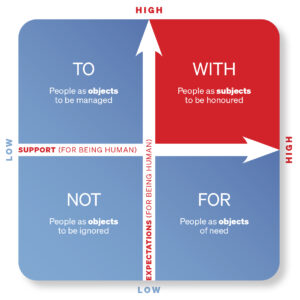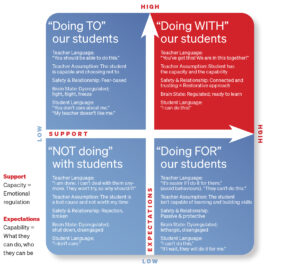CORONAVIRUS (COVID-19) AND SCSBC’S RESPONSE: Find the lastest updates here for students, faculty and staff.
CORONAVIRUS (COVID-19) AND SCSBC’S RESPONSE: Find the lastest updates here for students, faculty and staff.

When we speak to educators about the students they work with today, the overwhelming response is that students are not who they were in the past. Educators new to teaching express that these students are very different from when they were students. One study expressed how teachers struggled with the behaviour of students when they returned to school during the COVID pandemic, feeling that behaviour had ratcheted up (Fray et al., 2023). Haidt (2024) cites many reasons for the shift we are seeing in students, including the impact of technology and phones on students, parenting styles that prioritize safety over risk whereby the decision-making capacity of children has been reduced, and societal shifts that have reduced the amount of time that students engage in play. Haidt believes that each of these factors has contributed to the increase in stress we see in our students. In our current reality, educators can struggle with their identity as a teacher, identifying that their students are “not where they are supposed to be.” Teachers feel pressure to support students to “catch up” (Fray et al., 2023). The shift in the capacity and capability of our students may also impact an educator’s perception of their students, which can trickle down to a student’s identity as a learner. Students who are struggling can result in misattributions by teachers, peers, and themselves for the student’s inability to live by classroom rules can be viewed as intentional defiance and labeled as poor character (Faith, Bush, and Dawson, 2022).
In an era when school can be a difficult place for both students and educators, we want to emphasize that we believe learning needs to start with the value of the individual. “I praise you because I am fearfully and wonderfully made; your works are wonderful, I know that full well” (Psalm 139:14). We can’t overemphasize enough to our students and our educators that they are worthy and that they have value.
The authors of this paper have been studying the link between restorative practices and the brain’s stress response. Educators have struggled with the concept of what it means to be restorative, for restorative can have the connotation, “make it like it was.” A friend once said to us, “When I think of restorative, I think of my 1940s home. I don’t want it to be what it was in 1940. I want it to be what it can be today.” Moving forward, we define restorative as: supporting someone to be who they can be. We write this paper because of the hope we have for both students and educators, seeking to walk with them to be who they can be, through the learning that happens each day in our schools. We trust in the words of Paul, in Philippians 1:6, believing that God has started a good work in our students, and that he might use us to continue the work that He promises to complete.
Understanding Learning and the Brain/Body Response to Stress
What if there was a different way of “seeing” today’s student that could radically change how we understand and support them? Our brains are an amazing aspect of creation. We have so much capacity for learning and creativity and yet how we are wired might also be getting in the way. We are primarily wired for safety and relationship (Winfrey & Perry, 2021). This means that when we become stressed, our brains default to seeking safety. This is critical in the context of learning because stress physically gets in the way of learning. Stress is a chemical response between the brain and the body, an internal wiring designed to protect us.
All information we receive from the world comes in through our senses—vision, hearing, smell, taste, touch and vestibular—and is carried via our spinal cord to our brain stem which is our most primitive safety site responsible for the automatic life-sustaining functions including breathing, heart rate, blood flow, and digestion. From here, the information is passed onto the limbic system, which includes the amygdala, and is considered our fight-flight-freeze system, where our brain decides subconsciously if we are safe. Information is then passed onto our prefrontal cortex which is the centre of the universe for learning. Some functions of the prefrontal cortex include sound decision-making and planning, control over emotions, self-awareness, empathy, and learning (Siegel & Payne-Bryson, 2011).
How does stress impact our learning? Stress is a normal function of our brain, and we all experience it. The challenge with stress is when it becomes greater than our brain’s capacity to manage it. Stress is primarily managed by our limbic system, which is constantly monitoring our world for threats (like a smoke detector) and when it senses smoke it activates our stress response (alarm). The challenge is that our limbic system, like the smoke detector, can’t tell the difference between smoke from burnt toast and burning house smoke: it just triggers a stress response to smoke. When our stress alarm system is triggered, the limbic brain reduces or stops sending information to our prefrontal cortex, reducing the brain’s capacity to “think” in the moment. We, therefore, act before we are able to think (Winfrey & Perry, 2021). The more the limbic brain is activated by stress, the greater and faster the stress response happens. This stress response is behind some of the behaviour we see in our classrooms. Our students’ stress responses can include defiance, yelling, cursing, leaving the classroom, checking out, refusing to work, constantly being tired, and being unmotivated (Brummer, 2020). Stress reduces the access we have to our prefrontal cortex, reducing our ability to “think” our way through problems, make better decisions, regulate our emotions, and ultimately learn. The outcome of high stress results in many of the behaviours we see. Behaviour is the language our nervous system uses when it can’t find words (Brummer, 2020).
Another component of our safety system is that it causes us to default to negative thinking (Vaish, Grossmann, & Woodward, 2008). If our brain is wired to detect threats, it means we are wired to look for danger or the negative. How does this impact us as teachers in the classroom? It means we are wired to notice negative behaviour because in the classroom, a student engaging in negative behaviour becomes a threat to our teaching and classroom management. We will see students behaving poorly and often miss them performing positively. This focus on negative behaviours can become problematic for a student who is often getting in trouble and rarely receiving positive experiences: their brain is wired for safety and relationship, but the student may experience neither. Seeing our students differently, not as individuals displaying defiant behaviour—rather as students who are fearfully and wonderfully made, are capable, and can grow in their capacity and capability—requires us to shift to a stress response lens. Stress is what is getting in the way of the student meeting your expectations at that moment. How we relate to our students is key to creating a safe learning environment.
Walking “With” our Students
Vaandering (2014) proposed the Relationship Window (Fig. 1) as a model for understanding how “power influences people’s engagement with one another” (p. 515).

The horizontal axis expresses the support, nurture, and/or care we provide to others while the vertical axis expresses the expectations we have for others to be human. Expectations include both what we believe a student can do and who we believe a student can be. When we work with a high degree of support but low expectations, we work FOR our students. In the context of the classroom, we might say that FOR is teachers protecting or harbouring their students. In this quadrant, the brain is dysregulated as a result of disengagement. On the other hand, if we work out of high expectations and low support, we are doing things TO them. In the context of the classroom, we might say that teachers seek to move their students forward through control and compliance (Webb, 2018). In terms of the brain, the student is dysregulated in their need to fight, freeze, or flee. A classroom culture that provides low support and low expectation falls in the NOT quadrant. This is a learning environment based in negligence, and in which educators avoid engaging with students, perhaps even failing to engage students in the learning process. The NOT brain is dysregulated as a result of shutting down, with few to no expectations, and little to no support.
In summary, Vaandering (2014) expresses how the quadrant we are situated in reveals how we view others, and how we use our power as educators. When our relationships reflect the NOT quadrant, we view people as objects to be ignored. When our relationships are situated in the TO quadrant, we see others as objects to be managed. When classroom learning reflects the FOR quadrant, we see our students as objects of need. Each of these quadrants fails on some level to meet the needs of our students for being human.
The student-educator relationship based in high support and high expectations is in the restorative, or WITH quadrant. Vaandering (2014) states that when the student-educator relationship exhibits the WITH quadrant, we view students as subjects to be honoured. This student is situated in an environment of safety, connection, and trust, a space where they are ready to learn. VanderVennen (2016) describes working out of the WITH domain as working out of secure attachment: “It is both a safe haven (high emotional support) and a launching pad for exploration (high expectations and high degrees of challenge), the domain most amenable to learning” (p. 130). When an educator conveys high expectations to a student, they express that they believe in who the student can be. An environment is established that focuses on what one is capable of rather than learning deficits. When an educator can provide high support, they indicate to students that they are walking with them, regulating student stress as they engage in their learning journey.
When the student-educator relationship is working out of with-ness, or high support and high expectations, the WITH relationship can develop to be a two-way street. Educators provide high support for students while exhibiting high expectations for what students can do and who they can be. At the same time, students have high expectations for their teachers, believing in who the teacher can help them become as a learner, while providing high support for their teacher. A fully restorative classroom culture reveals with-ness in the student-student relationship, whereby students provide high expectations and high support for each other (Webb, 2018). This is a culture that fulfils the description of a community of one body found in Romans 12:5, where each member belongs to all the others.
Capability, Capacity, and Assumed Skills
A perspective of learning that combines a stress response lens and a restorative environment of high expectations and high support can be conceptualized by a framework of capability and capacity (Apers, 2020). Capability refers to the skills—physical, social, emotional regulation, executive functions, and academics—we develop over time from direct teaching and learning. Capacity is our ability to perform these skills in the moment and is heavily dependent on our level of stress, our coping tools, and how much energy we have. For example, as an adult we would assume that we have well-developed skills (physical, social, emotional, etc.) and therefore we have high capability. As adults, we also have high capacity in that we can regulate ourselves in moments of stress and challenge. However, we all have situations where we may not respond well in the moment. This is a result of our ever-changing capacity. Viewing our students in terms of capability and capacity allows us to pause and ask ourselves a critical question: “What is getting in the way of this student being successful?” Do they have areas of lagging skills (capability)? Have we seen them demonstrate the skill but they can’t do it right now (capacity)? Framing a student’s learning around capability and capacity leads us to approach their support differently. For this framework supports us in seeing our students in terms of hope rather than in terms of despair. Ultimately this can support both the capacity of the student and the educator for creating a learning environment that supports flourishing for the entire classroom community.
Assumptions can impede our ability to see a student’s capability and capacity. A student’s capability is dependent on two key factors: their developmental stage and the skills they have been directly taught. A five-year-old will have limited skill development in emotional control compared to a sixteen-year-old. We assume limited emotional control in a five-year-old because they have not yet developed this skill. We assume emotional control in the sixteen-year-old, so when we see a lack of emotional control in them, we might think that the behaviour we are seeing is deliberate and disrespectful. (Remember, our brain defaults to seeing the negative). We can look at ‘assumed skill’ another way. When we give a student a test, we likely assume that they have been taught how to study for a test. Poor results on the test then indicate that they don’t know the material or did not study. But what if students are reaching your class and have never been taught how to study for a test? Over-assumption of learned skills is very prevalent in middle and high school (Croasdaile, 2023), to the point that when the teachers see behaviour in the classroom the assumption is it is due to a lack of motivation, disrespect, or deliberate intent to derail a lesson rather than the brain’s stress response to lagging skills (capability) and/or limited capacity. If we can sit in a space of curiosity about capability (skills/lagging skills – they have not fully learned this yet) and capacity (they have demonstrated this skill before but can’t do it in this moment) it fundamentally changes how we see and support our students. Curiosity becomes the starting point for walking WITH our students in high expectations and high support. We have represented our conceptualization of stress and the brain, the restorative Social Discipline Window, and capability and capacity as the Learning Readiness Window (Fig. 2).

The Learning Readiness Window expresses expectations in terms of capability and support in terms of capacity. It is the educator language and assumptions that determine the quadrant. This influences safety and relationships, student language and assumptions, and ultimately the brain state. Each quadrant expresses a progressive reaction, starting with an educator’s language and assumptions. This impacts safety and student-educator relationships, influencing brains state, and ultimately the student’s response language or thoughts. Ultimately, the window expresses how educators have the ability to influence learning readiness, establishing environments that increase student capacity, and entering learning where they can grow in what they are capable of.
Buber (1923/1970) and Bradbury and Lichtenstein (2000) refer to the need to study the space between, the medium where individuals interact and evolve together. Educators have the privilege of intentionally creating the space, shifting from a space that is simply a collection of students where they may experience distance and isolation, to a space that is built on connection, relationship, and community. We are seeking to create student-educator spaces that students want to enter and participate in, rather than spaces that students want to flee: a restorative classroom is a space students want to come back to the next day. Through working with our students, through high support and high expectations, we support regulation in our students to decrease stress and increase capacity. This is ultimately about increasing capacity, and placing students in a position where they can engage with learning. Our deep hope is that in this context, our students may fulfil what they are capable of and become who they can be.
Reflection Questions
Owen Webb has served as an educator for the past 22 years, serving as the Director of Learning at Pacific Christian School in Victoria, BC for the past two years. He previously worked at Hamilton District Christian High as the Dean of Students, and as a math and geography teacher. Owen completed his PhD in 2018 in Educational Leadership, focusing on restorative practices as a means for supporting students and educators, and developing school culture.
Liz Ullrich has been working in education as an occupational therapist for over 30 years. As a Non-Violent Crisis Intervention Instructor she has seen an ever-increasing shift in classroom behaviour. Her experience has led her to see a connection between stress, brain function, and learning. She provides training to schools across British Columbia as a Learning Leader for the Society of Christian Schools of BC, equipping educators with knowledge to support today’s students.
References